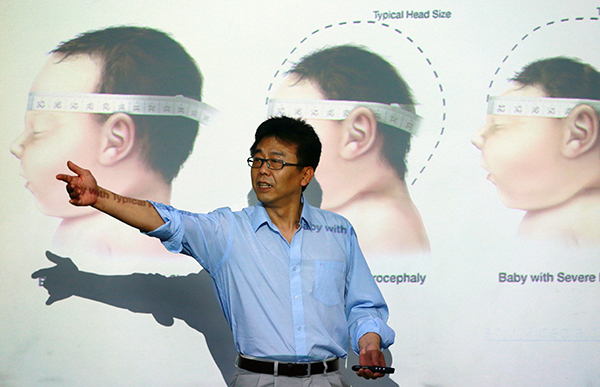Chinese team cracks Zika secret
Updated: 2016-05-12 07:08
By Zhao Xinying/Cheng Yingqi(China Daily)
|
||||||||
Research shows a link between the virus, poor brain development
 |
|
Researcher Xu Zhiheng explains findings of a Chinese team studying the Zika virus in Beijing on Wednesday. [Photo by Zou Hong/China Daily] |
A research finding by Chinese scientists that was published in a leading academic journal identified a direct link between the Zika virus and microcephaly-a disorder in which the head is small due to a defect in brain development.
The research was a collaboration between Xu Zhiheng, principal investigator at the Institute of Genetics and Developmental Biology under the Chinese Academy of Sciences, and Qin Chengfeng, a professor of virology at the Institute of Microbiology and Epidemiology under the Academy of Military Medical Sciences.
The authors published their findings on Wednesday in Cell Stem Cell, a monthly journal that focuses on important findings in stem cell research. They showed that mouse fetuses injected with the Asian Zika virus that were carried to term displayed characteristic features of microcephaly.
As expected, the virus infected neural progenitor cells, and the brains revealed genetic signs of viral entry, altered immune response and cell death. The authors said that's direct evidence that Zika infection causes microcephaly in a mammal.
The Zika virus has broken out in South America and been spreading around the world since 2015-including China.
"Zika is not a newly discovered virus, but its breakout in 2015 attracted more attention than ever before because more than 6,000 babies born in Brazil from March 2015 to March 2016 were diagnosed with microcephaly. Most of these babies' mothers were infected by the Zika virus," Qin said.
Until now, no direct connection between Zika and microcephaly has been found. According to Xu, mutations of about 30 human genes could cause microcephaly.
Recently, a research team of scientists from the United States and Brazil published a finding in Nature, showing that the Brazilian Zika virus strain could lead to birth defects.
But the Chinese research went further, Xu said. The most surprising finding was that it was mostly neural progenitor cells that became infected at the beginning, and mostly neurons infected at a later stage, five days after injection, when the presence of Zika virus increases several hundredfold.
"However, almost all cell deaths were found in neurons other than neural progenitor cells," Xu said. "This indicates that neurons, not neural progenitor cells, are prone to induced cell death by the Zika virus."
Xu said he hoped the finding would lay a good foundation for further research and control of the virus. The animal model, together with the global data sets of infected brains, "will provide valuable resources for further investigation", he said.
Symptoms generally mild
Zika is a virus that is primarily spread by mosquito bites. In general, the symptoms known to be caused by the virus tend to be mild. They include fever, rash, pain in the joints and pink eye. Symptoms usually occur two to seven days after infection. Many people who are infected do not show any symptoms, and those who do can be treated easily. Zika was first found in Africa and spread to Asia and Latin America. The virus is spreading rapidly in Latin America, while Thailand and the Philippines are the most Zika-infected countries in Asia.
Contact the writers at zhaoxinying@chinadaily.com.cn
- Russia to build first cruise liner in 60 years
- LinkedIn, Airbnb match refugees with jobs, disaster survivors with rooms
- Duterte 'willing to improve ties' with Beijing
- Canadian PM to introduce transgender rights bill
- Hillary Clinton says her husband not to serve in her cabinet
- New York cake show designs fool your eyes

 China Daily, celebrating 35 years
China Daily, celebrating 35 years
 Six things you may not know about Grain Buds
Six things you may not know about Grain Buds
 China Beijing International High-tech Expo
China Beijing International High-tech Expo
 Highlights at Google I/O developers conference
Highlights at Google I/O developers conference
 Nation celebrates International Museum Day
Nation celebrates International Museum Day
 Body brushwork creates vivid animals
Body brushwork creates vivid animals
 Can you still recognize these cities?
Can you still recognize these cities?
 A private museum owner's devotion to cultural protection
A private museum owner's devotion to cultural protection
Most Viewed
Editor's Picks

|

|

|

|

|

|
Today's Top News
Liang avoids jail in shooting death
China's finance minister addresses ratings downgrade
Duke alumni visit Chinese Embassy
Marriott unlikely to top Anbang offer for Starwood: Observers
Chinese biopharma debuts on Nasdaq
What ends Jeb Bush's White House hopes
Investigation for Nicolas's campaign
Will US-ASEAN meeting be good for region?
US Weekly

|

|





